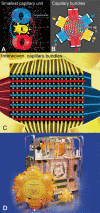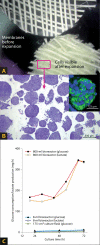Interwoven four-compartment capillary membrane technology for three-dimensional perfusion with decentralized mass exchange to scale up embryonic stem cell culture
- PMID: 20197653
- PMCID: PMC2895759
- DOI: 10.1159/000291014
Interwoven four-compartment capillary membrane technology for three-dimensional perfusion with decentralized mass exchange to scale up embryonic stem cell culture
Abstract
We describe hollow fiber-based three-dimensional (3D) dynamic perfusion bioreactor technology for embryonic stem cells (ESC) which is scalable for laboratory and potentially clinical translation applications. We added 2 more compartments to the typical 2-compartment devices, namely an additional media capillary compartment for countercurrent 'arteriovenous' flow and an oxygenation capillary compartment. Each capillary membrane compartment can be perfused independently. Interweaving the 3 capillary systems to form repetitive units allows bioreactor scalability by multiplying the capillary units and provides decentralized media perfusion while enhancing mass exchange and reducing gradient distances from decimeters to more physiologic lengths of <1 mm. The exterior of the resulting membrane network, the cell compartment, is used as a physically active scaffold for cell aggregation; adjusting intercapillary distances enables control of the size of cell aggregates. To demonstrate the technology, mouse ESC (mESC) were cultured in 8- or 800-ml cell compartment bioreactors. We were able to confirm the hypothesis that this bioreactor enables mESC expansion qualitatively comparable to that obtained with Petri dishes, but on a larger scale. To test this, we compared the growth of 129/SVEV mESC in static two-dimensional Petri dishes with that in 3D perfusion bioreactors. We then tested the feasibility of scaling up the culture. In an 800-ml prototype, we cultured approximately 5 x 10(9) cells, replacing up to 800 conventional 100-mm Petri dishes. Teratoma formation studies in mice confirmed protein expression and gene expression results with regard to maintaining 'stemness' markers during cell expansion.
Copyright 2010 S. Karger AG, Basel.
Figures





Similar articles
-
Compartmental hollow fiber capillary membrane-based bioreactor technology for in vitro studies on red blood cell lineage direction of hematopoietic stem cells.Tissue Eng Part C Methods. 2012 Feb;18(2):133-42. doi: 10.1089/ten.TEC.2011.0305. Epub 2011 Dec 28. Tissue Eng Part C Methods. 2012. PMID: 21933020 Free PMC article.
-
Dynamic 3D culture promotes spontaneous embryonic stem cell differentiation in vitro.Tissue Eng Part C Methods. 2010 Feb;16(1):115-21. doi: 10.1089/ten.TEC.2008.0654. Tissue Eng Part C Methods. 2010. PMID: 19382830 Free PMC article.
-
Periodic harvesting of embryonic stem cells from a hollow-fiber membrane based four-compartment bioreactor.Biotechnol Prog. 2016 Jan-Feb;32(1):141-51. doi: 10.1002/btpr.2182. Epub 2015 Nov 3. Biotechnol Prog. 2016. PMID: 26486457
-
A two-stage perfusion fibrous bed bioreactor system for mass production of embryonic stem cells.Expert Opin Biol Ther. 2008 Jul;8(7):895-909. doi: 10.1517/14712598.8.7.895. Expert Opin Biol Ther. 2008. PMID: 18549321 Review.
-
Scalable Expansion of Pluripotent Stem Cells.Adv Biochem Eng Biotechnol. 2018;163:23-37. doi: 10.1007/10_2017_26. Adv Biochem Eng Biotechnol. 2018. PMID: 29085956 Review.
Cited by
-
The multiparametric effects of hydrodynamic environments on stem cell culture.Tissue Eng Part B Rev. 2011 Aug;17(4):249-62. doi: 10.1089/ten.TEB.2011.0040. Epub 2011 May 25. Tissue Eng Part B Rev. 2011. PMID: 21491967 Free PMC article. Review.
-
Bioreactors addressing diabetes mellitus.J Diabetes Sci Technol. 2014 Nov;8(6):1227-32. doi: 10.1177/1932296814548215. Epub 2014 Aug 26. J Diabetes Sci Technol. 2014. PMID: 25160666 Free PMC article. Review.
-
Evaluating Strategies to Assess the Differentiation Potential of Human Pluripotent Stem Cells: A Review, Analysis and Call for Innovation.Stem Cell Rev Rep. 2025 Jan;21(1):107-125. doi: 10.1007/s12015-024-10793-5. Epub 2024 Sep 28. Stem Cell Rev Rep. 2025. PMID: 39340737 Free PMC article. Review.
-
Optimization of a serum-free culture medium for mouse embryonic stem cells using design of experiments (DoE) methodology.Cytotechnology. 2010 Dec;62(6):557-71. doi: 10.1007/s10616-010-9307-8. Epub 2010 Sep 22. Cytotechnology. 2010. PMID: 20859764 Free PMC article.
-
Effect of inoculum density on human-induced pluripotent stem cell expansion in 3D bioreactors.Cell Prolif. 2019 Jul;52(4):e12604. doi: 10.1111/cpr.12604. Epub 2019 May 8. Cell Prolif. 2019. PMID: 31069891 Free PMC article.
References
-
- Abbott A. Cell culture: biology's new dimension. Nature. 2003;424:870–872. - PubMed
-
- Abranches E., Bekman E., Henrique D., Cabral J.M.S. Expansion of mouse embryonic stem cells on microcarriers. Biotechnol Bioeng. 2007;96:1211–1221. - PubMed
-
- Adewumi O., Aflatoonian B., Ahrlund-Richter L., Amit A., Andrews P.W., Beighton G., Bello P.A., Benvenisty N., Berry L.S., Bevan S., Blum B., Brooking J., Chen K.G., Choo A.B.H., Churchill G.A., Corbel M., Damjanov I., Draper J.S., Dvorak P., Emanuelsson K., Fleck R.A., Ford A., Gertow K., Gertsenstein M., Gokhale P.J., Hamilton R.S., Hampl A., Healy L.E., Hovatta O., Hyllner J., Imreh M.P., Itskovitz-Eldor J., Jackson J., Johnson J.L., Jones M., Kee K., King B.L., Knowles B.B., Lako M., Lebrin F., Mallon B.S., Manning D., Mayshar Y., McKay R.D.G., Michalska A.E., Mikkola M., Mileikovsky M., Minger S.L., Moore H.D., Mummery C.L., Nagy A., Nakatsuji N., O'Brien C.M., Oh S.K.W., Olsson C., Otonkoski T., Park K.Y., Passier R., Patel H., Patel M., Pedersen R., Pera M.F., Piekarczyk M.S., Pera R.A.P., Reubinoff B.E., Robins A.J., Rossant J., Rugg-Gunn P., Schulz T.C., Semb H., Sherrer E.S., Siemen H., Stacey G.N., Stojkovic M., Suemori H., Szatkiewicz J., Turetsky T., Tuuri T., S. van den Brink, K. Vintersten, S. Vuoristo, D. Ward, T.A. Weaver, L.A. Young, W. Zhang. Characterization of human embryonic stem cell lines by the International Stem Cell Initiative. Nat Biotechnol. 2007;25:803–816. - PubMed
-
- Aleckovic M., C. Simó. Is teratoma formation in stem cell research a characterization tool or a window to developmental biology? Reprod Biomed Online. 2008;17:270–280. - PubMed
-
- Blum B., Benvenisty N. The tumorigenicity of human embryonic stem cells. Adv Cancer Res. 2008;100:133–158. - PubMed

